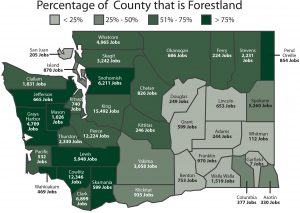This time of year is particularly special for working forests and the forestry sector because the third week in October is designated as National Forest Products Week. This is a time for US residents to recognize and honor the important contributions working forests and the forestry sector provide for the nation, state and local communities.
Working forests and the forest products sector is deserving of such accolades because of its positive impact on so many aspects of our lives. Wood is an environmentally friendly and renewable resource that offers multiple uses and applications in commercial, public, and home construction, landscaping, public infrastructure, furniture, housewares, visual art, musical instruments, shipbuilding, toys, sports equipment, biofuel, tools, paper, food, medicine, clothing, feedstock, and even cosmetics. Working forests also provide wildlife habitat, improve air and water quality, and offer recreational opportunities for hikers, hunters, and snowshoers.
As Washington Forest Protection Association Executive Director Jason Spadaro says:
“No other industry does what we do. Every day, trees in working forests absorb greenhouse gases from our atmosphere and store it in the trunks, branches, leaves and roots. When the trees are sustainably harvested, the carbon remains locked in throughout a wood product’s lifespan. The forest products industry is the only economic sector that reverses the state’s carbon emissions, while also providing public environmental benefits and employing thousands of people across our state. And we sustain that cycle by replanting three trees for every one tree harvested.”
The timber sector accounts for the state’s third-largest manufacturing industry, supporting more than 102,000 Washington workers and generating $5.6 billion in annual wages. In fact, forestry jobs support families and local communities within all 39 of Washington’s counties.

Working forests and forest products are a natural choice. Trees naturally take carbon dioxide from the atmosphere and convert it into wood. In fact, wood is roughly 50% carbon by weight. After a tree is sustainably harvested, that carbon remains sequestered in the wood product, making long-lived wood products like homes, furniture, instruments, and other durable items into carbon stores.
It is the potential of carbon storage why builders, designers and manufacturers, and consumers are demanding the use of more wood in place of more carbon-intensive materials like plastic, steel, and concrete. And the desire to use more wood products is ever-increasing as society endeavors to search for climate solutions and reduce greenhouse gas emissions, suggesting that the timber sector can further grow in Washington state.
So, here’s to working forests and the forestry products sector! From the private forest landowner to the silviculturist, to the sapling planters, to the loggers and wood product manufacturers, thank you all for providing the forestry products that contribute to our quality of life, economy, history, and wellbeing!
